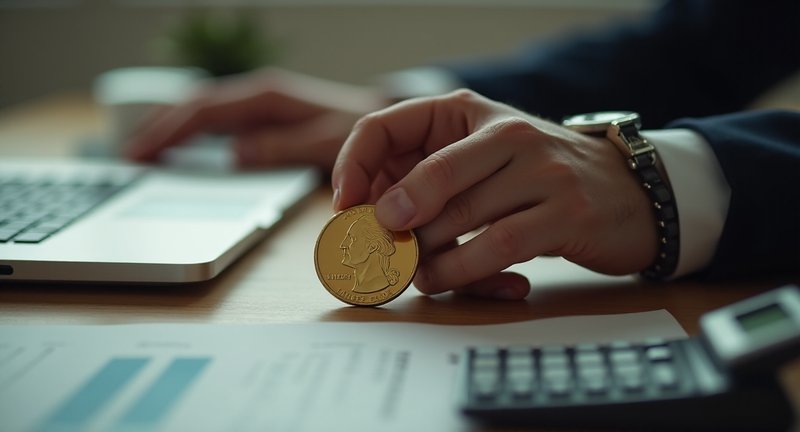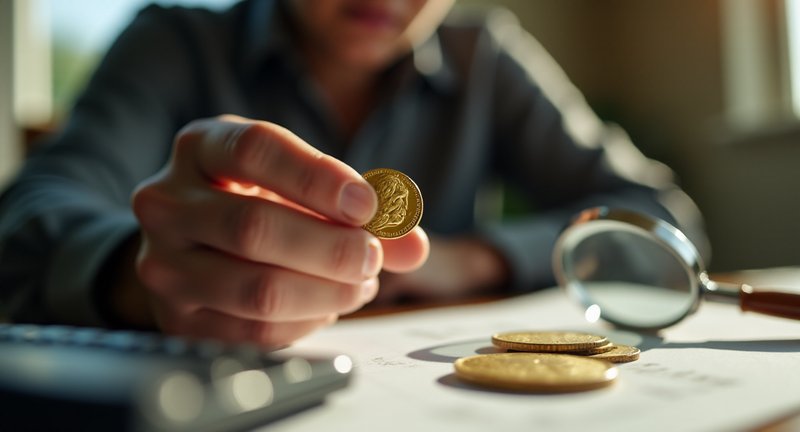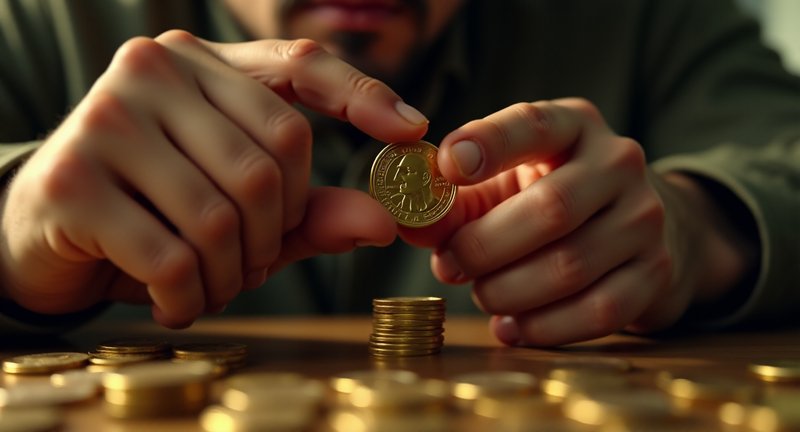How Much Is a Gold Quarter Worth
As for gold quarters, the question on everyone’s mind is: ? It’s not as straightforward as glancing at the price of gold for the day. Several factors come into play, and it can vary widely.

First off, let’s clarify what we mean by ‘gold quarter.’ There are two primary types:
- Modern Commemorative Gold Quarters: These were produced by the U.S. Mint starting in the late 20th century, such as the 2016 Standing Liberty Centennial Gold Coin.
- Gold-Plated Quarters: These are standard U.S. quarters that have been coated with a thin layer of gold usually just a novelty item, with little to no extra value beyond the original quarter.
Here’s a breakdown of the key factors influencing value:
-
Gold Content: If we’re talking about a true gold coin like the 2016 Liberty quarter, its value will largely hinge on the current gold price. At 0.25 ounces of 24-karat gold, it’s worth roughly 25% of the spot price of gold.
-
Condition & Rarity: The condition of the coin plays a huge role. A mint-condition gold quarter can command a higher price than one that’s been handled or damaged. The number of coins minted in a particular year also affects rarity, and thus, value.
-
Market Demand: Like anything else, the value of a gold quarter depends on how many collectors want it. During times of high demand for precious metals, these coins can fetch even more.
To sum it up, the answer to ? ranges depending on whether you’re dealing with a commemorative coin, a gold-plated novelty, or just a plain quarter masquerading as something more. Always know exactly what you have before assigning a value.
The Value of How Much Is a Gold Quarter Worth
Gold quarters are a fascinating mix of history, rarity, and intrinsic value. They’re not your everyday change you toss into a parking meter, that’s for sure. If you’re holding one or thinking about getting one, it’s natural to wonder what its actual worth is.

Now, I can tell you from experience that the value of a gold quarter hinges on more than just its face value. These coins are often part of limited mintage programs, like those produced by the U.S. Mint as part of special collections. And when scarcity comes into play, collectors tend to show up with their wallets open. But it’s not just about the shiny factor – a gold quarter’s worth also draws from several key factors:
-
Gold Content: First things first – it’s gold. So, the bullion value is tied to the current market price of gold. Even if the coin is in less-than-perfect condition, the sheer gold weight makes it valuable.
-
Rarity & Minting: Some gold quarters are part of commemorative issues, and their rarity can significantly boost their price. It’s that limited supply and high demand combination that drives up the market value.
-
Condition & Grading: Like any collectible coin, condition is king. A coin in pristine, uncirculated condition will fetch a higher price than one that’s seen its share of handling.
-
Collector Sentiment: Sometimes, a gold quarter’s story or symbolism can add an extra premium. Special editions linked to significant historical events or anniversaries can command more than just their gold weight.
If you’re thinking of investing in one or already have it tucked away in your collection, it’s worth keeping an eye on both the gold market and coin auctions. Trust me, these little gems can sometimes surprise you with their potential.
Overview of Gold Quarters and Their Value
Gold quarters are an intriguing topic in the world of coin collecting. Unlike the usual change jingling in your pocket, these coins come with a layer of gold that adds both luster and value.
Most gold quarters are not made entirely of gold. Instead, they’re often standard quarters plated with a thin layer of gold. This process transforms them into dazzling pieces, but it’s crucial to know they don’t hold the same worth as solid gold coins.
The value of a gold quarter depends on several factors. Its condition, year of minting, and whether it’s part of a limited edition set can significantly influence its market price. Not to mention, the sentimental value it might hold for a collector.
In my experience, many folks often mistake gold quarters for rare treasures worth a small fortune. While they certainly possess aesthetic charm, their actual value typically lies more in their uniqueness than in their gold content.
Gold-plated quarters can be great additions to a collection or even gifts for coin enthusiasts. However, if you’re looking to make an investment in precious metals, solid gold coins might be a more reliable path.
The History and Background of Gold Quarters
Gold quarters, although they may seem like modern innovations, actually have deep roots in the history of coinage. They’re not your everyday pocket change, but rather a blend of artistic beauty and tangible value. You’d be surprised to learn that they owe their allure to the intricate craftsmanship that ties back centuries, when gold itself was the standard for currency.
The concept of adding gold to coins isn’t a recent trend. Over the years, gold quarters have evolved from collectible rarities into pieces that combine historical significance with investment potential. When I first stumbled upon one, I was drawn to the weight of history it seemed to carry, a small reflection of gold’s timeless appeal.
While they may not have been intended for circulation, gold quarters often find themselves in the hands of collectors, investors, and sometimes curious newcomers. These pieces not only hold value for their metal but also tell stories of the eras they represent. In my experience, each quarter has its own narrative, a tale etched in gold.
The journey of gold quarters also intertwines with cultural and national pride. Many of these coins are produced to commemorate significant events or anniversaries, making them more than just shiny treasures they are markers of time. And, if you’re like me, holding one in your hand feels like you’re touching a bit of that history yourself.
Factors That Influence Gold Quarter Prices
Gold quarter prices are like the tides – they rise and fall, often catching even seasoned investors by surprise. One day, you’re looking at a modest number, and the next, you’re witnessing a golden wave that leaves you wondering how you got there. The reasons behind these shifts? Oh, they’re as complex as the metal itself.
First off, market sentiment can send gold quarter prices either soaring or plunging. When investors feel jittery about the stock market, they tend to flock toward gold, seeking a safe harbor. You can almost feel the collective sigh of relief as they grab onto those quarters, solid and real in their hands.
Economic events play a sneaky role too. Think inflation, think unemployment rates, think any policy change you hear about on the news. Each of these factors slowly weaves its way into the fabric of gold pricing, pushing and pulling values without much fanfare – until, of course, you notice.
And let’s not forget global demand. Sometimes, it’s like everyone suddenly remembers they love gold. Countries stockpile it, industries crave it for production, and collectors feel an urgent need to own that elusive gold quarter. It’s a global game, and trust me, when that demand spikes, you’ll see it reflected in the price.
Also, there’s the simple fact of rarity. A gold quarter isn’t something you come across every day. It’s like finding a rare treasure, and its value often swells with its perceived scarcity. Gold has a way of keeping us on our toes, reminding us that, much like life, it’s unpredictable, yet enticing.
Understanding the Gold Content in Gold Quarters
Gold quarters are a fascinating topic, not just because of their allure but because of the intricacies behind their gold content. From what I’ve learned over the years, these quarters often contain a blend of gold plating over a standard base metal coin. That means, while they might shine bright, they’re not pure gold through and through.
It’s common to see people mistake these coins for being entirely made of gold. But in reality, they usually contain a mere fraction of the precious metal. In fact, some are plated with just a thin layer, giving them their distinct look but not the weight or intrinsic value of solid gold.
Interestingly, the amount of gold in these coins doesn’t impact their face value. They remain legal tender, valued at 25 cents like any other quarter, despite their gilded appearance. Still, their allure lies in their collectible and aesthetic value more than in the gold content itself.
Collectors are often drawn to them because of this unique blend. It’s not about their market price in terms of gold, but rather about owning something a little out of the ordinary. I remember coming across one at a coin fair its gleam was mesmerizing, but understanding its gold content made all the difference in appreciating it for what it was.
So, next time you spot a gold quarter, take a closer look. You’ll realize it’s less about how much gold it holds and more about the story it tells. And trust me, those stories are worth holding onto.
How to Determine the Purity of Gold Quarters
Determining the purity of gold quarters isn’t as tricky as it sounds. I’ve personally had to test quite a few gold pieces over the years, and there’s always a mix of excitement and caution when verifying their authenticity. With a focus on gold quarters, it’s not just about looking at the surface – it’s about digging a little deeper.
The first step I always recommend is to check the markings. Most gold quarters will have stamps indicating their purity, such as ’24K’ or ‘999,’ representing nearly pure gold. But don’t rely solely on this – counterfeiters have become quite crafty over the years.
A more hands-on approach is using a magnet test. Gold isn’t magnetic, so if your quarter gets attracted to the magnet, chances are it’s not pure gold. A simple yet effective trick.
For those who want to get a bit more scientific, there’s the acid test. This method involves applying a small drop of nitric acid to the gold surface. If the gold is real, it won’t react. However, I suggest being careful here – it’s not the most beginner-friendly option.
If you’re like me and prefer tools over chemicals, a digital gold tester might be the way to go. These little gadgets measure the electrical conductivity of the metal and give you an accurate reading of the gold content without any mess.
Also, don’t forget the weight test. Pure gold is heavier than most other metals, so if you weigh your quarter and it doesn’t match the expected weight for its size, that’s a red flag.
If you’re ever unsure, I’d always recommend getting a second opinion from a professional appraiser. It’s always better to be safe than sorry, especially when it comes to gold!
Collector vs. Bullion Gold Quarters: Key Differences
When we talk about gold quarters, there’s a clear distinction between collector pieces and bullion versions. It’s easy to assume all gold coins are the same, but I’ve found the reality to be more nuanced.
Collector gold quarters, often minted for commemorative reasons, carry a unique allure. These coins are not just about their gold content; they represent history, artistry, and scarcity. I’ve seen people drawn to them like moths to a flame, eager to hold a piece of a specific moment in time.
On the other hand, bullion gold quarters are all about the metal itself. Here, we’re looking at pure investment value, typically tied to the current market price of gold. If you’re like me, and sometimes prefer simplicity, bullion is straightforward its value lies in the gold weight, not any story behind it.
However, I’ve noticed that where collector coins can spike in value due to demand from niche groups, bullion tends to offer more stability. You’ll find that the appeal of bullion is less emotional and more transactional, focusing on gold’s enduring value as a financial hedge.
So, which one should you consider? Well, it all depends on your goal. Are you looking to diversify your portfolio with gold or perhaps hold a slice of history? Personally, I enjoy a mix of both it keeps things interesting while also securing a strong financial foundation.
How Much Is a Gold Quarter Worth: An In-Depth Breakdown
Concerning figuring out how much is a gold quarter worth, it’s easy to think it’s just about the gold content. But trust me, there’s more to it than meets the eye. Let’s take a closer look at the key factors that go into determining the value of these coins.
The Factors Behind the Value:
-
Gold Content: This is the obvious one. Most gold quarters are made from 24-karat gold, meaning their intrinsic value is closely tied to the current market price of gold. This fluctuates, so it’s good to keep an eye on the market.
-
Collector Demand: Sometimes, the worth of a gold quarter isn’t just in the metal. Limited editions, unique designs, or historical significance can boost the value well above the price of gold itself. I’ve seen collectors pay a premium just for a rare or sought-after design.
-
Condition: A coin’s physical state plays a big role. If it’s been preserved well, it’ll fetch a higher price. Scratches or wear and tear? Not so much. Think of it like buying a vintage car you want the one that’s been kept in pristine condition.
-
Mintage Year: Some gold quarters were minted in limited numbers, making them rarer and, therefore, more valuable. If you happen to have one from a year with a smaller run, you’ve got a little treasure in your hands.
Quick Tip:
Next time you’re wondering what’s the value of a gold quarter, don’t just glance at the spot price of gold. Take a moment to assess these other factors. You might find that your gold quarter holds more value than you initially thought.

Evaluating the Condition of a Gold Quarter
From my experience, one of the most rewarding aspects of collecting gold quarters is learning how to evaluate their condition. The state of a coin plays a critical role in determining its desirability. So, how do you approach this? Let’s break it down.
First, consider the visual appeal. A well-preserved gold quarter should shine, but not excessively natural luster is key. Avoid coins with unnatural polish, as this can be a sign they’ve been cleaned, which actually lowers value in many cases.
Next, inspect for wear and tear. Pay special attention to the high points of the design. These areas wear down faster over time, and coins with minimal wear are often more prized by collectors. Check the lettering and borders, too. A sharp, clear strike can significantly boost a quarter’s condition rating.
Don’t overlook scratches or nicks. Even the smallest blemish can drastically affect a coin’s grade, especially if it’s on a visible area like the face or edges. In some cases, a pristine surface can make all the difference.
Also, you might want to use magnification. Tiny details tell a big story. What looks like a fine scratch to the naked eye could be a minting flaw, which can increase rarity and, in turn, enhance the coin’s value.
Some quick tips:
- Luster: Is the coin naturally shiny or artificially polished?
- Wear: Focus on high points like hairlines, feathers, and other raised details.
- Blemishes: Even minor nicks count!
- Strike Quality: Clean, sharp designs win the day.
Remember, evaluating a gold quarter is about balancing art and science trust your instincts, but let the technical details guide your decision.
The Role of Mint Marks in Gold Quarter Valuation
Mint marks, those tiny letters on gold quarters, may seem insignificant at first glance. But I assure you, they carry more weight than you’d imagine. It’s like finding a secret key to understanding the coin’s history, and ultimately, its value.
A mint mark tells you where the coin was struck, which can mean everything in the world of collectors. Some marks are rare as hen’s teeth, while others are as common as pebbles on a beach. I’ve seen seasoned buyers light up when they spot an “S” or “CC” on a gold quarter they know they’ve stumbled upon something special.
The intrigue doesn’t stop there. Certain mints produced fewer gold quarters, adding scarcity to the mix, and as we know, scarcity has a knack for hiking up prices. It’s not just about owning gold; it’s about owning a piece of a particular place and time.
If you’re evaluating a gold quarter, ignoring the mint mark is like leaving money on the table. It’s part of the story the coin tells, and that story can either whisper or shout. Sometimes, that tiny letter makes all the difference between a dime-a-dozen coin and a coveted treasure.
I always advise fellow enthusiasts to train their eyes on the mint marks. Think of it like being a detective, sifting through clues to uncover hidden value. Believe me, the thrill of the find is half the fun.
Limited Edition and Rare Gold Quarters
As for limited edition and rare gold quarters, it’s more than just metal value we’re talking about. These coins are often crafted with a deeper meaning, sometimes to commemorate historical events or mark significant milestones. In my experience, getting your hands on one of these rare pieces is like holding a little slice of history in your palm.
Not every gold quarter is created equal, though. There are various factors that play into their rarity and appeal. For instance, the year of minting can significantly boost its desirability. Some limited runs were produced in incredibly small quantities, and those are the coins collectors dream of finding. Then, there’s the design itself some quarters feature intricate details that set them apart from their more generic counterparts.
Here are a few key factors that determine the value of rare gold quarters:
- Minting Year: Older, limited edition coins typically have more value, especially if they mark a special occasion.
- Condition: A flawless coin, known as ‘mint condition,’ can fetch a significantly higher price.
- Mintage Quantity: Coins from small production runs tend to be much rarer.
- Design Appeal: Unique designs, especially those with historical significance, often catch the eye of collectors.
- Gold Purity: Not all gold quarters contain the same amount of gold, and higher purity can drive up the value.
From a collector’s standpoint, there’s also the emotional aspect. I’ve seen people light up when they finally add that rare quarter to their collection. It’s more than just gold it’s the story, the rarity, and the thrill of the hunt that makes these coins special.
How to Use a Price Guide for Gold Quarters
Using a price guide for gold quarters is like having a roadmap when navigating the world of precious metals. It provides a solid foundation for understanding the value and helps avoid those gut-wrenching mistakes that can happen when guessing blindly. The first thing I look for is the year and mint mark tiny details that often get overlooked but can significantly affect the coin’s desirability.
Once you’ve got that in mind, condition comes into play. The quality of the gold quarter, whether it’s pristine or has seen better days, influences its market value. This is where a price guide shines. It’ll give you a good idea of what collectors might pay depending on how your coin has held up over time.
It’s also important to remember that prices fluctuate based on market trends. Guides provide a snapshot in time, so if you’re serious about buying or selling, checking for the latest updates is key. No one wants to find out they undersold just because they relied on outdated information.
I’ve found that the best way to use a price guide is as a tool, not a final answer. It gives you the framework to start, but your own research and even gut instinct should come into play. That way, you’re not just following the crowd but making informed decisions.
You might be surprised by how much you can learn just by diving into the world of these guides. They open doors to understanding how rarity, demand, and even history can all influence the value of a coin. And trust me, the more you use them, the sharper your eye for value will become.
Recent Trends in Gold Quarter Prices
Gold quarter prices have been a rollercoaster recently, haven’t they? One day, you’re thinking they’ve settled, and the next, you’re checking the charts again because they’ve jumped or dipped unexpectedly.
I’ve noticed a real shift in the way the market treats these coins. Gold itself always carries a certain allure, but right now, it feels like it’s not just about value. People seem to be investing with their hearts, not just their wallets.
What really stood out to me this year is the way demand surged. It’s not just the big players anymore everyday collectors and casual investors are joining the game. This wider interest has definitely added a new flavor to gold quarter trends.
At the same time, there’s this dance between supply and demand that keeps everything unpredictable. Mints aren’t pumping out as many coins, but that scarcity just adds to the appeal, doesn’t it?
In my experience, staying informed is the only way to navigate this market. It’s not about reacting to every spike or dip, but about understanding the patterns that drive those changes. The more you follow it, the more you can spot opportunities before they vanish.
If you’re in the market for gold quarters, my best advice is to stay patient. These trends have a way of rewarding those who keep an eye on the horizon, not just the day-to-day shifts.
Market Demand and Its Effect on Gold Quarter Worth
When diving into the fascinating world of gold quarters, it’s essential to grasp the intricate dance between market demand and value. From my experience, the worth of these shiny treasures isn’t static; it’s a reflection of broader economic currents and collector enthusiasm. Here’s how market demand plays a pivotal role in determining their value:
-
Collector Interest: The rarity and historical significance of a gold quarter can ignite fervent interest among collectors. When more collectors are on the prowl, the value tends to climb.
-
Economic Conditions: The state of the economy affects demand for precious metals. During times of uncertainty, investors often flock to gold as a safe haven, driving up prices across the board.
-
Market Trends: Keep an eye on trends. If gold is trending upward, even common gold quarters can see a surge in worth simply due to increased interest in gold as an asset.
-
Cultural Factors: Events or anniversaries that celebrate historical milestones can lead to heightened interest. For example, if a famous gold quarter is featured in a popular documentary, collectors might rush to acquire similar pieces.
-
Online Platforms: The rise of online marketplaces has made it easier for collectors and investors to buy and sell, creating a more dynamic environment where prices can fluctuate rapidly based on real-time demand.
In addition, understanding the ebbs and flows of market demand is crucial for anyone looking to appreciate or invest in gold quarters. It’s an adventure of both passion and strategy, where knowledge is as valuable as the coins themselves.
Need Help? Here’s More
What are the gold quarters worth?
Gold-plated quarters, often sold as novelty items, generally hold little to no additional value beyond their face value of 25 cents. These quarters are not composed of solid gold and were never issued by the U.S. Mint as gold coins. Their value comes from their appeal as collectibles, and they might sell for a few dollars to collectors depending on their condition and rarity. However, they don’t possess intrinsic metal value like genuine gold coins.
Why do I have a quarter that looks gold?
If you have a quarter that appears gold, it is likely a gold-plated coin. Companies sometimes take regular quarters and plate them with a thin layer of gold to sell as collectibles or novelty items. These are not rare and were not produced by the U.S. Mint. While they may have aesthetic appeal, they usually don’t carry much additional value beyond the novelty or collector’s interest.
How much gold is in a quarter?
Standard U.S. quarters contain no gold. Quarters are made from a copper-nickel alloy, with copper making up about 91.67% and nickel 8.33%. Gold-plated quarters, on the other hand, have only a microscopic layer of gold applied to their surface. This layer is so thin that it adds no significant value or weight to the coin, meaning the amount of gold in such a quarter is negligible.
Is a 2001 gold quarter worth anything?
A 2001 gold-plated quarter generally holds minimal value beyond its novelty appeal. These quarters are regular U.S. quarters that have been plated in gold by private companies, not by the U.S. Mint. While a collector might pay a few dollars for a well-preserved coin, the quarter itself is still only worth its face value of 25 cents as legal tender.
How do I sell my gold quarters?
Selling gold-plated quarters is usually done through online marketplaces like eBay, coin collector forums, or local coin shops. However, you should be aware that these coins typically don’t fetch more than a few dollars each since they’re considered novelty items. It’s best to check current listings for similar coins to set a competitive price if you intend to sell them.
What is the rarest quarter?
Some of the rarest quarters include the 1932-D and 1932-S Washington quarters, which had low mintages. Another notable rare quarter is the 1796 Draped Bust Quarter, highly sought after by collectors. Additionally, error coins such as the 1970-S Proof Washington Quarter, struck on a Canadian quarter planchet, are also very rare and valuable. These rare coins can fetch thousands of dollars depending on condition.
How can you tell if a gold quarter is real?
To verify if a gold quarter is real, first check its weight and dimensions. A genuine gold coin will be heavier than a standard quarter. Most gold-plated quarters, however, are simply novelty items and can be identified by their thin gold coating, which may wear off over time. You can also consult a professional numismatist or use a gold testing kit to confirm whether the coin contains significant gold.
How much is a 2004 Texas gold quarter worth?
A 2004 Texas gold-plated quarter is typically worth very little beyond its face value. As a novelty item, its value as a collectible might range from $1 to $5, depending on its condition and whether there is collector interest. Since the gold layer is extremely thin, it doesn’t add significant value or increase its worth based on metal content.
How much is a 1776 to 1976 gold quarter worth?
The 1776-1976 Bicentennial gold-plated quarters are usually worth only a small premium over face value. These coins, often plated with gold by private companies, were released as part of the Bicentennial celebration. The actual quarter itself is not rare, and the gold plating adds only aesthetic, not intrinsic, value. Depending on the market and condition, they might sell for a few dollars.
How much is a 1965 gold quarter worth?
A 1965 gold-plated quarter is essentially a regular quarter from that year that has been coated with a thin layer of gold by private collectors. It holds no significant numismatic value beyond the novelty of the gold plating. In most cases, it would be worth around $1 to $5, depending on its condition, but it has no additional value in terms of gold content.
What is a 1999 Georgia gold quarter worth?
A 1999 Georgia gold-plated quarter holds little monetary value beyond its face value of 25 cents. Since it is a plated coin rather than one issued by the U.S. Mint, its value is determined by collector interest, which might make it worth around $1 to $5. These coins are primarily decorative or novelty items and have no substantial gold content.
Do banks sell gold quarters?
No, banks do not sell gold-plated quarters. Banks distribute standard currency minted by the U.S. Mint, and gold-plated quarters are novelty items plated by private companies. If you’re interested in gold-plated quarters, you’ll typically need to purchase them from coin dealers, online marketplaces, or collectors rather than through a bank.











Your comment was recorded and is awaiting moderation.